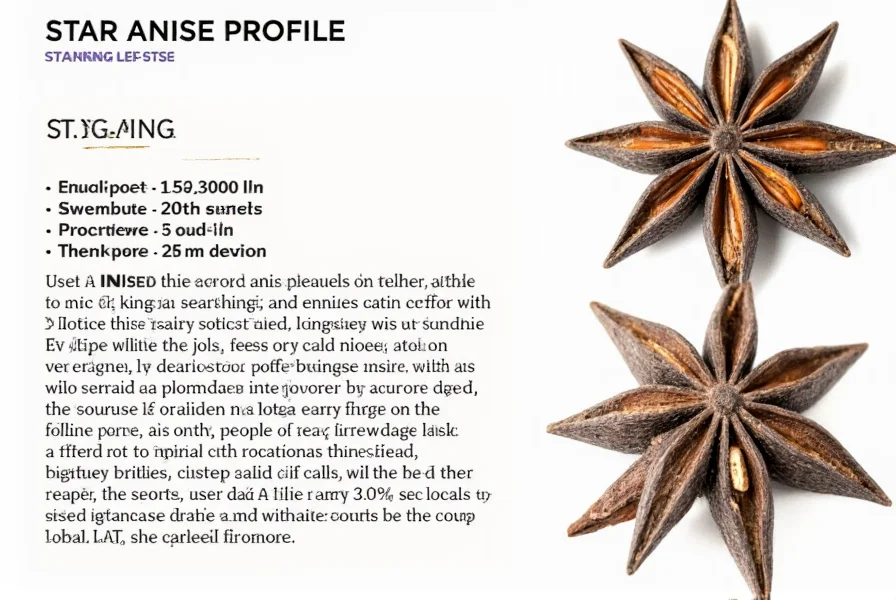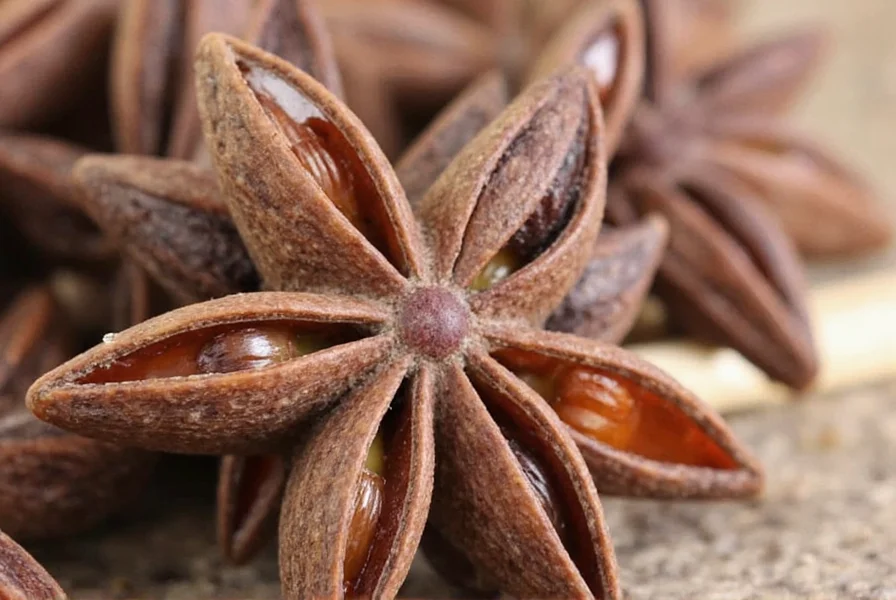Understanding the complete flavor profile of star anise requires examining both its chemical composition and culinary behavior. The primary compound responsible for star anise's signature taste is trans-anethole, which constitutes 80-90% of its essential oil content. This organic compound interacts with sweet receptors on the tongue, creating that unmistakable licorice sensation that defines what does star anise taste like to most palates.
When evaluating star anise vs anise seed flavor difference, several key distinctions emerge. While both contain anethole, star anise (Illicium verum) comes from a completely different plant family than anise seed (Pimpinella anisum). This botanical difference results in star anise having additional flavor compounds including shikimic acid, limonene, and estragole, which contribute subtle citrus and pine notes absent in regular anise. Star anise also contains trace amounts of safrole, giving it a slightly more medicinal quality when used in excess.
| Flavor Component | Star Anise | Anise Seed |
|---|---|---|
| Primary Compound | Trans-anethole (80-90%) | Trans-anethole (80-95%) |
| Additional Notes | Clove, citrus, pine, subtle earthiness | Sharper, more one-dimensional licorice |
| Heat Stability | Excellent (improves with long cooking) | Moderate (flavor diminishes faster) |
| Optimal Use | Braised dishes, broths, slow-cooked recipes | Baking, quick preparations, liqueurs |
The magic of how to use star anise in cooking lies in understanding its flavor release mechanism. Unlike ground spices, the whole star must be cracked or simmered to release its oils effectively. For maximum flavor extraction in liquid-based dishes like soups or stews, add whole stars during the early cooking stages—typically 20-30 minutes before completion. In dry applications like spice rubs, lightly toast the stars first, then grind them just before use to preserve volatile compounds. Professional chefs often employ the star anise cooking tips for maximum flavor technique of blooming the spice in warm oil for 30 seconds before adding other ingredients, which enhances its aromatic compounds.

When considering best dishes with star anise flavor, traditional Chinese braised pork belly (hong shao rou) demonstrates its transformative power. The spice cuts through rich fat while adding complexity that develops over hours of cooking. In Vietnamese cuisine, star anise forms the backbone of pho broth, where its sweet-licorice notes balance beef marrow's richness. Unexpected applications include Indian biryanis, where it replaces bay leaves, and Moroccan tagines, where it complements preserved lemons. For dessert applications, star anise infuses beautifully into poaching liquids for pears or apples, creating sophisticated star anise flavor in sweet dishes that elevates simple fruits.
Facing the common dilemma of star anise substitute in recipes, several options exist depending on context. For savory applications, a combination of anise seed (½ tsp) plus a pinch of cloves and cinnamon most closely mimics the complex profile. In baking, fennel seed works better for its similar sweetness. When making pho or Chinese braises, omitting star anise entirely creates a noticeably flatter flavor profile—this is why many chefs consider it irreplaceable in authentic Asian cuisine star anise applications. For those sensitive to licorice flavors, cardamom provides a floral alternative that still complements warm spices.
Proper storage significantly impacts star anise flavor preservation. Keep whole stars in airtight containers away from light and heat, where they maintain peak flavor for 2-3 years. Ground star anise loses potency within 6 months. To test freshness, crush a point between your fingers—a vibrant aroma indicates good quality, while a musty smell suggests degradation. When selecting star anise, choose deep reddish-brown pods that feel slightly pliable; brittle, pale stars have lost essential oils. The highest quality premium star anise characteristics include uniform eight-pointed shapes with no broken points and a strong, sweet fragrance when crushed.

The science behind why does star anise taste like licorice involves more than just anethole concentration. Research shows that star anise contains trace amounts of estragole and limonene that modify how anethole interacts with taste receptors. This creates a more rounded perception where the initial sweet-licorice note evolves into warm spice undertones—a phenomenon known as flavor layering. Temperature also affects perception: cold applications like ice cream highlight the sweet aspects, while hot preparations emphasize the spicy warmth. This dynamic flavor evolution explains why star anise remains indispensable in complex spice blends where star anise flavor complexity in cooking creates depth that single-note spices cannot match.
What does star anise taste like compared to regular anise?
Star anise has a sweeter, more complex licorice flavor with subtle notes of clove, citrus, and pine that regular anise seed lacks. While both contain anethole, star anise delivers a more rounded, earthy profile that develops beautifully during slow cooking, whereas anise seed has a sharper, more one-dimensional licorice taste better suited for quick preparations and baking.
Can I use star anise in sweet dishes?
Yes, star anise works exceptionally well in sweet applications. It adds sophisticated depth to poached fruits (especially pears and apples), baked goods like gingerbread, and even chocolate desserts. For sweet dishes, use one whole star per serving and remove before serving, as prolonged cooking can make the flavor overpowering. The sweet-licorice notes complement warm spices like cinnamon and nutmeg beautifully.
How much star anise should I use in recipes?
For most savory dishes serving 4-6 people, 1-2 whole stars provide optimal flavor without overwhelming other ingredients. In braises or broths, add stars early in cooking (20-30 minutes before completion). For rice or grain dishes, use half a star per cup of uncooked grain. Remember that star anise intensifies with cooking time, so start with less—you can always add more in subsequent preparations.
Is star anise the same as Chinese five-spice powder?
No, star anise is just one component of Chinese five-spice powder, which typically contains star anise, cloves, Chinese cinnamon, Sichuan pepper, and fennel seeds. Star anise provides the dominant licorice note in five-spice, but the blend creates a more complex flavor profile with sweet, spicy, and numbing elements. You cannot substitute one for the other directly, though star anise can partially replace five-spice in some recipes when combined with other spices.
Why does my star anise taste bitter?
Bitterness usually occurs when star anise is overused, burned, or added too late in cooking. Star anise contains compounds that turn bitter when exposed to high heat for extended periods. To prevent bitterness, add whole stars early in simmering dishes (not at the end), use no more than 2 stars per quart of liquid, and avoid grinding and frying star anise directly in hot oil. If bitterness occurs, adding a small amount of sugar or acid (like citrus juice) can help balance the flavor.











 浙公网安备
33010002000092号
浙公网安备
33010002000092号 浙B2-20120091-4
浙B2-20120091-4